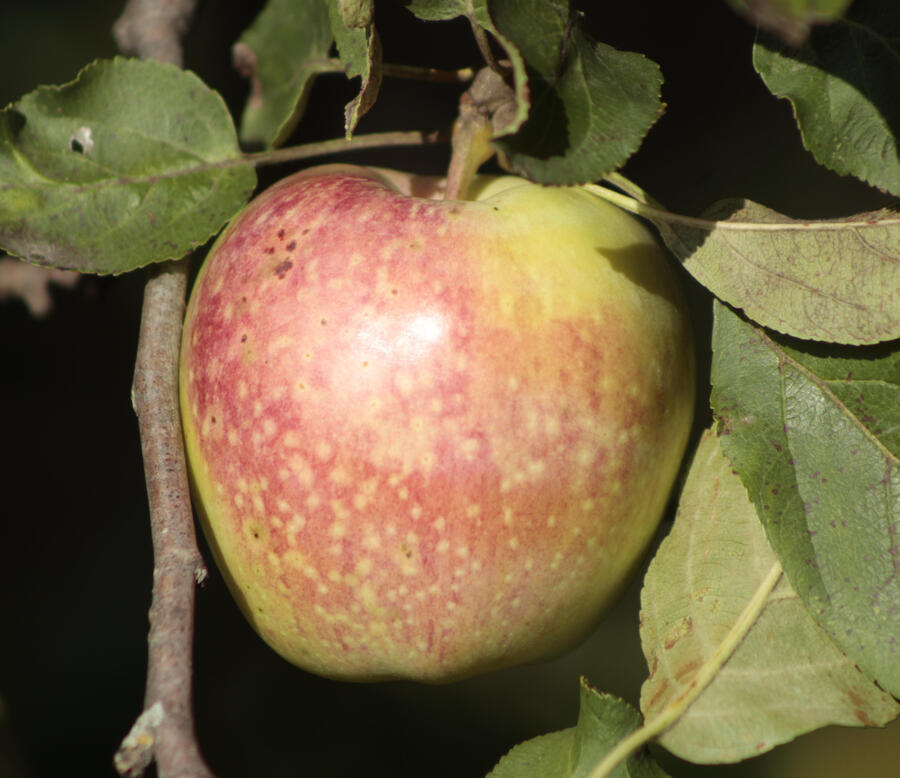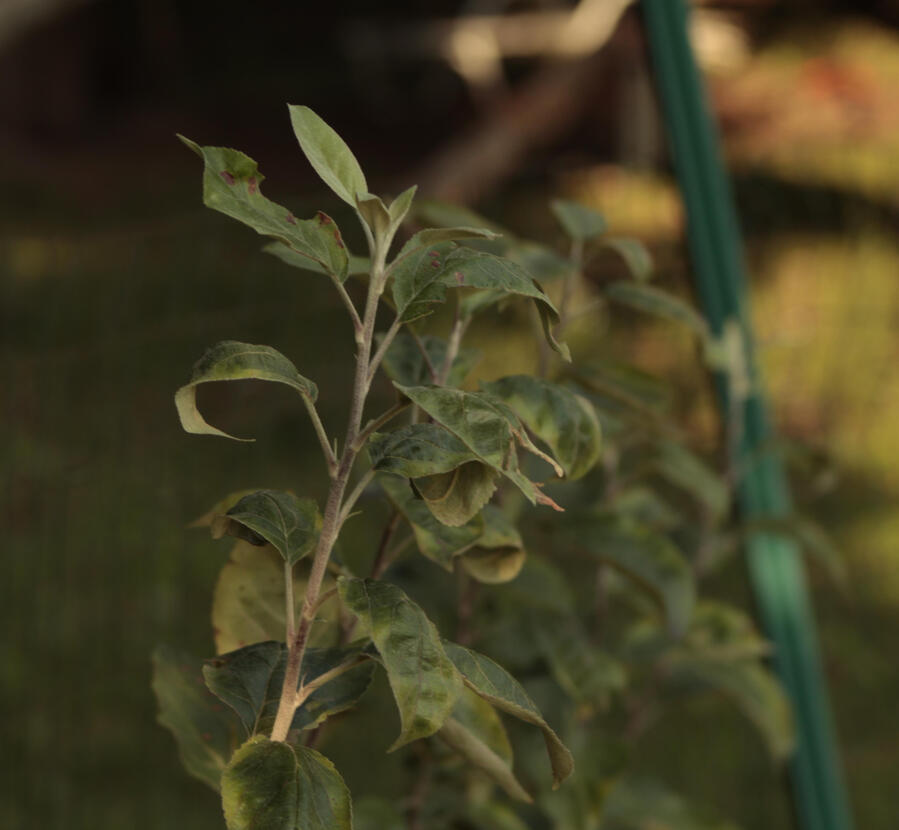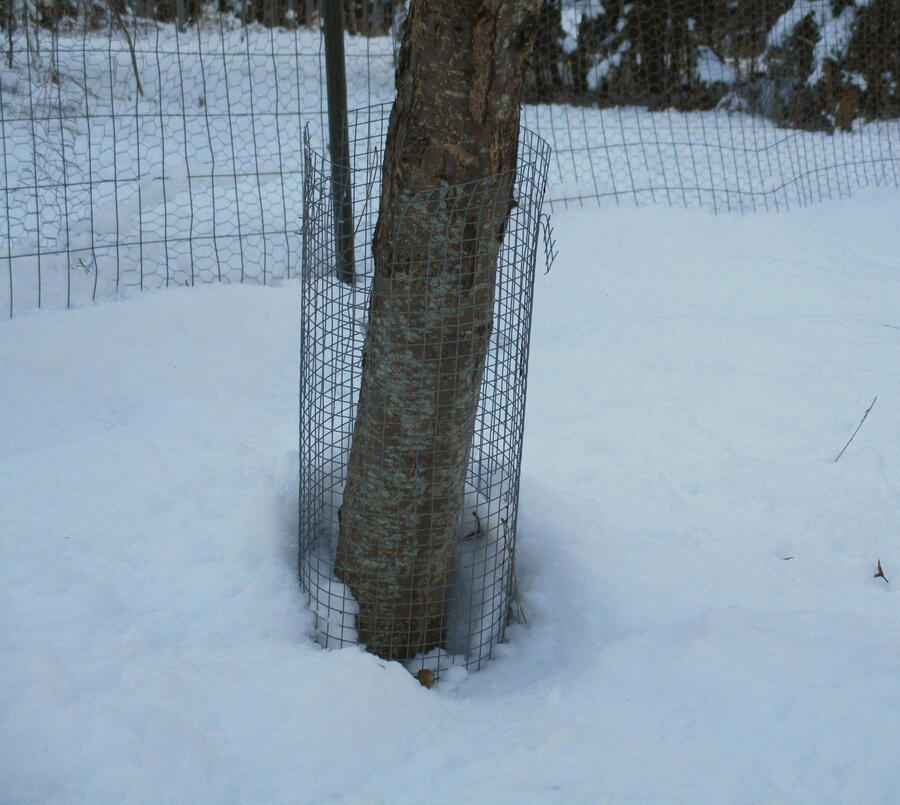Grafting season is here! We will be updating our website with new varieties once we verify what ones are in good condition for the spring.
Amnicon Apples
Heritage & Experimental Apples
We are a small apple nursery in the process of building the ability to produce numerous varieties of cold hardy apple trees in saleable quantities.
Contact Us or Place an Order
If you need information about ordering from us, look here. Also, we would love to hear from you!
Varieties

Our collection contains 50+ named and experimental apple varieties, with limited stock of about half of them. We haven't yet had a chance to see what trees are ready to sell for the 2025 season, but the below list should cover the types we have the most of. The names link to descriptions, and pictures if possible. All trees are grafted on hardy Bud 118 rootstock.
If you are interested in any of the listed varieties, feel free to ask us about availability. We will check our stock, and get back to you as soon as possible.A link to a list of our experimental varieties, as well as those we know we don't have in stock is at the bottom of the page.
A
C
D
F
G
H
M
S
W
Y
Unavailable Varieties
These apples are either known varieties which we have in our collection, but currently do not have the capacity to produce, or are varieties which we haven't decided are worth selling. AAX stands for Amnicon Apples Experimental, and denotes an unnamed apple we are growing to test or breed.
Named Varieties
Experimental Varieties
AAX 1
AAX 1 is poorly characterized. From small experience, the fruit are small, tart, red-striped crabapples. The original tree was broken off by heavy equipment, so we grafted it to have time to get a fuller understanding of the apple's traits.
AAX 2
AAX 2 is a large yellow and red crabapple that ripens mid-season. The fruit are extraordinarily sweet and tart both, making a strong but balanced flavor. When at peak, they are tender and fine-grained, with a touch of crunch. They hang well after peak, and they turn mealy quickly. This apple may be valuable for fresh cider, or fresh eating, but we have not given it a name, and currently are only growing it to further test its qualities.
AAX 3
AAX 3 is currently our only red-fleshed apple, and, as such, is highly interesting. Given the original tree's location, it may be an old named variety that has been lost to time, or a seedling grown for decorative purposes. The tree bears numerous dark pink flowers in spring, followed by thick coppery foliage, and conical pale pink apples. The apples ripen in September, have a texture much like a ripe Yellow Transparent, and are quite sour. To offset these traits, their flesh is brilliant pink, and that color carries over to sauce or jelly made from the fruit.
AAX 4
AAX 4 is our designation for an ancient tree belonging to an elderly family member, which we grafted to preserve for its personal value. It is a soft, tart, midseason cooking apple. It may be a named variety, but the history of the tree is lost to time.
AAX 5
AAX 5 is a wild apple found growing out of the foundation of a ruined outbuilding at an unoccupied farm. The fruit are mid-sized, oblate, and very yellow, with an occasional red blush. They are generally soft and fine-grained. Its flavor is mild, and seems fairly generic, except for a hint of a rich, fragrant note. If peeled, these make exceptional applesauce, and will probably be used to attempt to breed improved cold-hardy yellow apples.
AAX 6
AAX 6 is an apple found growing out of a spruce windbreak at the same farmhouse as AAX 5. The apples are large and flattened, with a green peel striped with pink across the sunny side of the apple. The flesh is tender, a little crisp, and incredibly juicy. The flavor is largely balanced, with primarily a generic fruity flavor, and a strange bite of harsh acid in the skin. The fruit are, unfortunately, susceptible to cracking, but are still an appealing apple.
AAX 7
AAX 7 earned its spot in the experimental list for its surprising flavor. It is yet another wild apple, and a pretty unattractive one at that, but when fully ripe, very late in the season, it has a strong and unmistakable flavor of green table grapes. The fruit is otherwise unremarkable, sized somewhere between a large crabapple and a small apple, with a thick skin and tough chewy flesh, although it is very sweet even when unripe. The tree is vigorous and spreading.
AAX 8
AAX 8 is one of three small trees that grew under the original Schoolbus tree, and is presumed to be a seedling from that parent. Based on this, it is included as an experimental, while a proper tree is grown out to bearing.
AAX 9
AAX 9 is one of three small trees that grew under the original Schoolbus tree, and is presumed to be a seedling from that parent. Based on this, it is included as an experimental, while a proper tree is grown out to bearing.
AAX 10
AAX 10 is one of three small trees that grew under the original Schoolbus tree, and is presumed to be a seedling from that parent. Based on this, it is included as an experimental, while a proper tree is grown out to bearing. The sprout from which this came has grown up and died back numerous times, and seems to be both very sturdy, and very prone to various diseases. It will hopefully get by these once planted out of the understory.
AAX 11
AAX 11 is an exciting wild seedling which bears small, brilliantly striped crabapples. The fruit are firm, almost tough, fine-grained, and slightly crunchy, with a burst of sourness and unusual flavors with each bite. Both the sourness and the texture moderate after harvest, leading to a both less shocking and more approachable eating experience. Although they are small, AAX 11 apples also cook well, making a delightful applesauce, and would fare well in baked goods, as well. A slight tannic note in the skin suggests the juice could have a place in cidermakeing, if mixed with something sweeter.
We will be eagerly following this tree's growth and production over the next several years. The growth seems promising from a grower's perspective, but bearing may prove to be irregular. As a whole, this apple has the potential to be quite interesting, both for its own qualities, and its breeding potential, if crossed with a larger, sweeter apple.
AAX 12
AAX 12 is a very large pale green apple with some light streaks of pink on the sunny face. The flesh is light and rich in juice, and is a balance of mild sweet and tart. The original tree is growing out of the roadbank by a nearby cemetery. This is a favorite apple of a couple of local families each fall.
AAX 13
AAX 13 is a medium slightly oblate apple, striped with some dark red. The fruit's tough skin covers soft juicy flesh with a slightly strange but pleasant sweet flavor.
Abbondanza
Abbondanza is a medium-sized green and red eating apple originating in Italy near the end of the 19th century. The thick skin covers fine-grained white flesh, often described as having a tart raspberry flavor. Ripening late in the fall, the fruit are supposed to keep for several months after picking. This apple was a popular commercial variety in Europe for the first half of the 20th century, until changes in public taste relegated it to home growers' orchards. Despite this, it is said to still be popular across most of the continent. We aren't certain of the variety's hardiness, but it has survived several winters, and we are hopeful. Our original cuttings came from the Temperate Orchard Conservancy, of Oregon.
Info:
Use: Fresh Eating, Cooking
Keeping: 5 Months
Bloom time: Uncertain
Ripening date: Uncertain, October (Northern Wisconsin)
Parentage: Unknown
Origin: San Pietro Capofiume, Italy - Discovered 1896
Amberwine
Amberwine is a new introduction from the breeding work of Steven Edholm, the creator of the SkillCult Youtube channel. It is a moderate sized conical apple, and is rich yellow, with red striping. The apple's flesh is described as dense and sweet, with little to no balancing acid, and a strong savory or wine-like flavor. Unfortunately, the texture does not last, making Amberwine's season short.
Info:
Use: Fresh Eating
Keeping: 1 Month
Bloom time: Uncertain
Ripening date: Uncertain, Early Season
Parentage: William's Pride x Vixen
Origin: Steven Edholm - Introduced 2022
Anis
Anis, also known as Anis Aliy, is an obscure Russian variety, described as the leading apple of the Volga region in the late 1800s. It is a small, flattened, thick-skinned green apple, with a splash of purplish-red on the sunny side. The greenish-white flesh is described as crisp, juicy, pleasantly sweet-tart, and generally of good quality. Historical sources also claim the tree is resistant to fire blight. Our original stock comes from the Temperate Orchard Conservancy, in Oregon.
Info:
Use: Fresh Eating
Keeping: 2 Months
Bloom time: Uncertain
Ripening date: Uncertain
Parentage: Unknown
Origin: Volga region, Russia - Unknown Date
Arctic
Arctic is a very hardy alternative to the old variety Baldwin originating in New York. It is described as medium-large, round to conical, with pale yellow-green skin mostly blushed and striped dark red, with a splash of russet around the stem. The flesh is coarse, crisp, and sweet, with just a touch of tart. Considered to be good or very good quality, especially for culinary uses. Our original stock comes from Fedco Trees, in Maine.
Info:
Use: All-Purpose
Keeping: 2 Months
Bloom time: Uncertain
Ripening date: Uncertain
Parentage: Unknown
Origin: Cape Vincent, New York - Introduced 1887
Aroostook Sunset
Aroostook Sunset is the first russet we have offered. Originating in northern Maine, it is adequately hardy for us to offer, unlike most russets. The blocky apples are largely bright pink, with large patches of gold colored russeting. They are described as sweet, with attractive fine-grained flesh, and are said to keep through the entire winter. Our original cuttings came from Fedco Trees, in Maine.
Info:
Use: All-Purpose
Keeping: 4 Months
Bloom time: Uncertain
Ripening date: Uncertain
Parentage: Unknown
Origin: Aroostook County, Maine - Unknown Date
August All-purpose
August All-purpose (formerly sold as August Sweet) is one of our own introductions. An early sweet eating variety, it can be picked under ripe for a crisp tart flavor, or when fully ripe for a softer, sweeter taste and texture. In either case, the flavor is delicate and intriguing. The flattened green apples are lightly striped with pink when in the sun. The ripe apples will keep for several weeks after picking. They ripen in late August.
Info:
Use: Fresh Eating, Sauce
Keeping: 3 Weeks
Bloom time: Group 3 (Mid Season)
Ripening date: August 19th (Northern Wisconsin)
Parentage: Unknown
Origin: Amnicon Apples - Introduced 2021

Burgundy
Burgundy is a large, flattened apple with dark blood red skin. The firm juicy flesh is described as having a balanced sweet-tart aromatic flavor, with some growers describing it as cherry-like. This flavor, as well as the pink staining throughout the flesh, make for very striking dried apples. The tree is described as vigorous, precocious, and productive, with the fruit hanging on the branches well. Unfortunately, the variety is also fairly susceptible to fire blight, meaning disease control is necessary.
Our original cuttings came from Fedco Trees, in Mane.
Info:
Use: Fresh Eating, Sauce, Drying, Cider
Keeping: 1 Month
Bloom time: Unknown
Ripening date: Unknown, Early-Mid Season
Parentage: Monroe x NY 18491 (Macoun x Antonovka)
Origin: New York Agricultural Experiment Station - Introduced 1974
Crowley's Pie
Crowley's Pie is a large late season cooking apple. The slightly conic apples are yellow-green, with a pale red flush, and are hard as rocks. Their stiff texture makes them very hard to bruise, and pleasantly crunchy when eaten. Unfortunately, their flavor isn't sweet enough for most tastes, although fans of tart apples will enjoy them. Holding its shape well when cooked, the variety is best suited for pies, although it can, with time, be cooked into a decent applesauce. The apples ripen around the beginning of October, and must then be used right away, as they begin turning brown and spongy almost immediately after ripening. This variety comes from an ancient home orchard. We cannot identify it, and assume it is a new variety. If you believe you can show us otherwise, please contact us.
Info:
Use: Fresh Eating, Pie, Sauce
Keeping: 2 Weeks
Bloom time: Group 3 (Mid Season)
Ripening date: October 7th (Northern Wisconsin)
Parentage: Unknown
Origin: Amnicon Apples - Introduced 2021

Dakota Gold
Dakota Gold is a large early season apple developed in North Dakota, and released in the 1960's. The large blocky apples are yellow, with a shiny, smooth peel. The trees are described as hardy, vigorous, regular producers, and are somewhat resistant to fire blight. The fruit ripen in early September, and keep for a couple of weeks. They are good for both fresh eating, and culinary uses, with a bright, slightly tart flavor, and a crisp texture. Our scions came from the Temperate Orchard Conservancy in Oregon.We originally described this variety as another variety, confusingly named Dakota, developed by the same experimental farm. We are glad to have sorted this out, and hope to acquire Dakota soon.
Info:
Use: Fresh Eating, Pie, Sauce
Keeping: 2 Weeks
Bloom time: Unknown
Ripening date: September 5th (Northern Wisconsin)
Parentage: Wealthy x Whitney
Origin: North Dakota State University & USDA - Introduced 1965
Dolgo Crab
Dolgo crab is a moderate-sized crabapple with an elongated profile, and red or burgundy skin. The creamy flesh is firm, fine-grained, but often mealy, with a harsh tart flavor often compared to cranberries. The strong but harsh flavor makes this variety most popular for jelly, as well as syrup, applesauce, and brewing into cider. The strongly colored skin lends a delightful pink color to all of those products. The tree produces vast quantities of long-lasting white flowers, which makes it both very decorative, and very good for pollinating other apples. Additionally, Dolgo is a vigorous and somewhat disease resistant variety, and begins bearing at a young age. The fruit ripen somewhat early in the season, and then hang on the tree, only slowly falling over the rest of the season.
Info:
Use: Sauce, Jelly, Cider
Keeping: 2 Weeks
Bloom time: Unknown
Ripening date: September 15th (Northern Wisconsin)
Parentage: Malus baccata (Siberian Crab) seedling
Origin: Collected in Russia by Dr. Niels Hansen in 1897, released by the South Dakota Experiment Station in 1917
Frostbite
Frostbite is an unusual dessert variety that only recently was given a name and introduced by the University of Minnesota. It formed the basis of their breeding program that led to Sweet Sixteen, Keepsake, and the wildly popular Honeycrisp. The apples are small and mostly covered in red mottling. The flesh is yellow, coarse, and crunchy, and the flavor is most often compared to molasses, sugarcane, or malt. While it may be sweeter than some people like, the apple is of outstanding quality, as demonstrated by its illustrious offspring. Ripening late in the season, the variety has a relatively short shelf life, making it mainly an autumn treat.
Info:
Use: Fresh Eating
Keeping: 1 Month
Bloom time: Group 4 (Late Season)
Ripening date: October 15th (Northern Wisconsin)
Parentage: Unknown
Origin: University of Minnesota - Introduced 2008
Gilpin
Gilpin is an old variety first recorded around the start of the 19th century in Virginia. The fruit are small to medium and slightly oblong, with a thick yellow and dark red striped skin. The fruit cling to the tree until the first hard frost, usually in October. At this point, the fruit are of very low quality, but they keep incredibly well. While the apples are most often used for cider, if they are left until late winter in storage, they become tender, or even slightly crisp, with a strong mostly sweet flavor, with a bit of balancing acid. The fruit will actually keep into the next summer, if stored properly. The tree is a slow grower, and is susceptible to biennial bearing and to cedar-apple rust. Our original cuttings came from the Temperate Orchard Conservancy, in Oregon.
Info:
Use: Fresh Eating, Cider
Keeping: 7 Months
Bloom time: Uncertain
Ripening date: Uncertain, October (Northern Wisconsin)
Parentage: Unknown
Origin: Virginia - Approximately 1805
Hanson Creek
Hanson Creek is one of our own varieties. It was found as a wild tree growing along the stream it is named for. Although it turned out to be a bit of a disappointment in flavor compared to what we thought, it makes a decent mild, tart, fine-grained applesauce. The apples are tart, becoming sweeter over time, but otherwise are not very flavorful. They keep for a little more than a month.

Haralson
Haralson is a classic apple variety throughout the upper Midwest, and is the first major success from the prestigious University of Minnesota breeding program. Genetic testing has shown Haralson to be a cross between Malinda and Wealthy. It inherits the traits for a tart, yet enjoyable flavor from Wealthy, while being significantly larger. The flesh is hard, with a little bit of crunch, and a great deal of juice, and is exceptionally well suited to pies.
Info:
Use: Pies, Fresh Eating
Keeping: 2 Months
Bloom time: Group 3 (Mid Season)
Ripening date: October 5th (Northern Wisconsin)
Parentage: Malinda x Wealthy
Origin: University of Minnesota - Introduced 1922
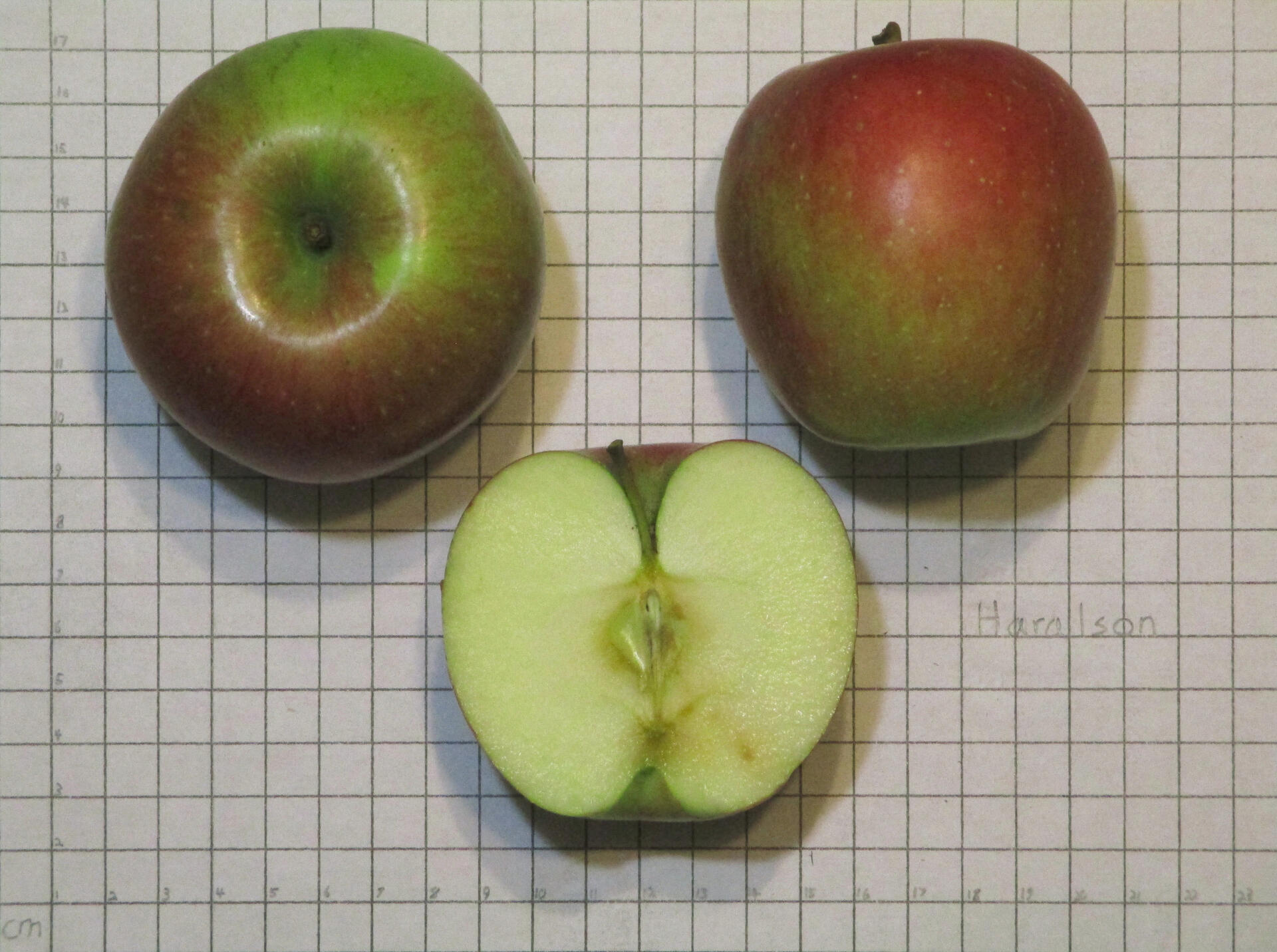
Hayford Sweet
Hayford Sweet is an ancient winter keeping apple from Maine. It was historically noted as being considerably more hardy than some of the other popular keeping apples. The apples are slightly oblate, and heavily striped and blushed blood red. The flavor is described as rich, and very sweet, but the texture is somewhat dry. Our origional stock came from Fedco Trees, in Maine.
Hewe's Virginia Crab
At least that is what we think this is. At peak quality, the small red apples are crisp, with a flavor which is a combination of equal parts sweet and sour, and a tiny bit of bitter on top. They quickly deteriorate after peak, cracking and becoming mealy, but will hang on the tree for an extended period. Exceptional for jelly, they are also supposed to be an excellent variety for hard cider. Our stock comes from the remains of an ancient orchard that nobody knows anything about. The fruit closely match this variety, but the identification isn't certain. If you believe you can positively identify this apple, please contact us.
Info:
Use: Cider, Jelly
Keeping: 2 Weeks
Bloom time: Group 2 (Early Season)
Ripening date: September 20th (Northern Wisconsin)
Parentage: Unknown
Origin: Virginia - Approximately 1700

Honeycrisp
Introduced in 1991 by the University of Minnesota, Honeycrisp is one of the most produced apples in in the US. The blocky apples are splashed yellow and red, and have firm brittle flesh. They will keep for the entirety of winter if properly stored, maintaining their texture and sweet flavor. The flavor is rich and sweet, with the faintest touch of acid to add interest. If they are too sweet for personal taste when fully ripe, they are tarter, but otherwise the same if picked slightly early. Honeycrisp ripen near the end of mid-season.
Info:
Use: Fresh Eating, Baking
Keeping: 4 Months
Bloom time: Group 4 (Late Season)
Ripening date: September 25th (Northern Wisconsin)
Parentage: Keepsake x MN1627
Origin: University of Minnesota - Introduced 1991

Minnewashta (Zestar)
Minnewashta, marketed as Zestar by the University of Minnesota, is a large blocky apple ripening in very early fall or late summer. The white flesh is light, tender, and slightly crunchy, with a matching delicate and sweet-tart flavor. The fruit are medium to large, round, with a creamy color where they aren't blushed bright crimson. When stored, the fruit will hold their texture for about a month, before starting to shrivel slowly. They hold their flavor well.
Info:
Use: Fresh Eating, Baking
Keeping: 2 Months
Bloom time: Group 2 (Early Season)
Ripening date: September 4th (Northern Wisconsin)
Parentage: State Fair x MN 1691
Origin: University of Minnesota - Introduced 1999
Minnehaha
Minnehaha is the first variety of apple introduced by the Minnesota breeding program, receiving its name in 1920. It is a large oblate apple with yellow skin generously coated with dark red. The off-white flesh is described as slightly crisp, moderately juicy, and aromatic, with a balance of sweet and tart. The tree is supposed to be vigorous and productive. Its crop ripens over an extended period, much like one of its parents, Wealthy. While Minnehaha has been overshadowed by newer varieties, historical literature notes it as good to very good quality.
Info:
Use: Fresh Eating, Baking
Keeping: 2 Months
Bloom time: Unknown
Ripening date: Unknown, Mid-Late Season
Parentage: Wealthy x (Ben Davis x Fameuse)
Origin: Minnesota Breeding Program - Introduced 1920
Minnesota Russet / MN 1734
MN 1734, also known as Minnesota Russet, is a blocky medium-sized apple covered in dark bronze russet.Note: There was a mixup in sourcing cuttings for this variety. Our trees this year are likely a different high-quality hardy apple variety, but we don't know which variety they are. Next year's stock will definitely be the real thing. We will gladly sell our stock if you want to gamble on what the trees are.
Northwest Greening
Northwest Greening is a large light green apple, sometimes with a splash of russet.
Pewaukee
Pewaukee is an old cooking variety. The original tree came from a seed of a Duchess of Oldenburg, planted in Pewaukee, Wisconsin. It was introduced by the planter around 1870, and tested widely both in the state, and elsewhere in the country. Reports differ on the hardiness and vigor of the tree, with modern growers in Maine claiming it is highly cold hardy and long lived, while a 1906 report from the Wisconsin Horticultural Society described it as tender, and apt to fail from one reason or another within only a few years. Both sources agree on the quality of the fruit. The yellow-green apples are large and blocky, with red striping. According to growers, the yellow flesh is crisp and juicy, and cooks very well, particularly for applesauce. Our origional stock came from Fedco Trees, in Maine.
Schoolbus
Schoolbus is undoubtedly the best of our own varieties. The apples are generally large, and heavily coated with red stripes. The fine-grained white flesh breaks when bit, and is richly fragrant and sweet. The apple does not cook down in the slightest, barely softening within any reasonable amount of time. Best used for fresh eating, they also make good dried apples.
The variety has a very long season, slowly becoming more sugary and crisp if left on the tree over the duration of a month in mid season. Unfortunately, if picked too soon, or grown in too shaded of a location, the skin of the apples does have a slight touch of drying astringency Fresh off of the tree, the apples are exceptional, and will keep for two to three months in storage, although they shrivel slowly, and change from a fruity to a caramely flavor.
Info:
Use: Fresh Eating, Drying
Keeping: 2-3 Months
Bloom time: Uncertain Early-Mid Season
Ripening date: September 10th (Northern Wisconsin)
Parentage: Wild seedling, possibly offspring of Red Delicious.
Origin: Amnicon Apples - Introduced 2021
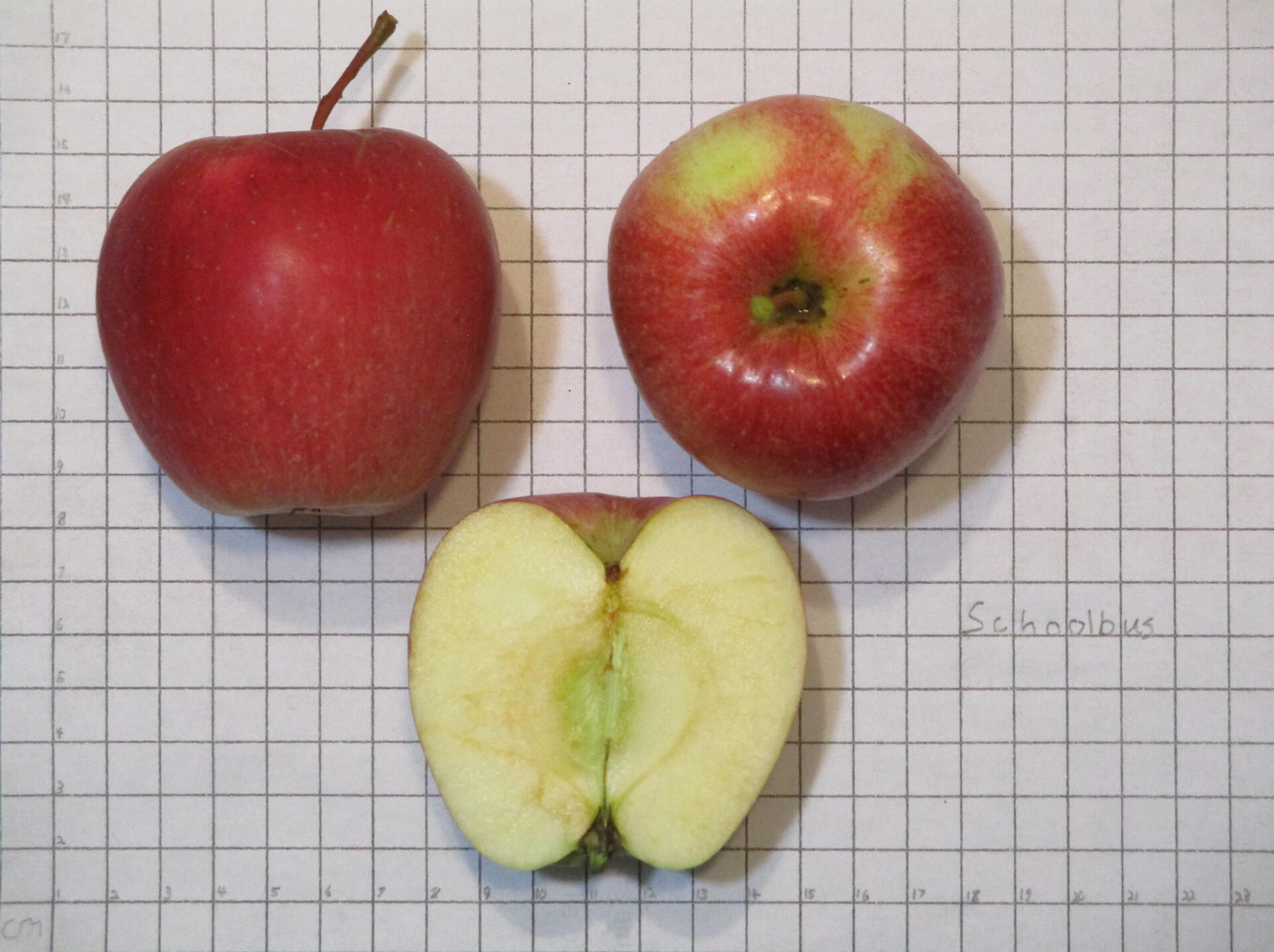
Sour Opal
Sour Opal is a massive late season apple. Wherever they are exposed to sun, the pale green apples are heavily striped with crimson. The flesh is coarse and soft, bruising very easily, and is highly sour and acidic. Because of the flavor, the only real use for the apple is cooking, for which it excels. If peeled, the apple will cook down to a fluffy yellow sauce in about 15 minutes. If picked and stored carefully, they will also keep several months. The stock for this apple comes from an ancient orchard, and it is believed to be a new variety. If you can show us otherwise, please contact us.
Info:
Use: Sauce
Keeping: 3-4 Months
Bloom time: Uncertain Early Season
Ripening date: September 30th (Northern Wisconsin)
Parentage: Unknown, old home orchard.
Origin: Amnicon Apples - Introduced 2021
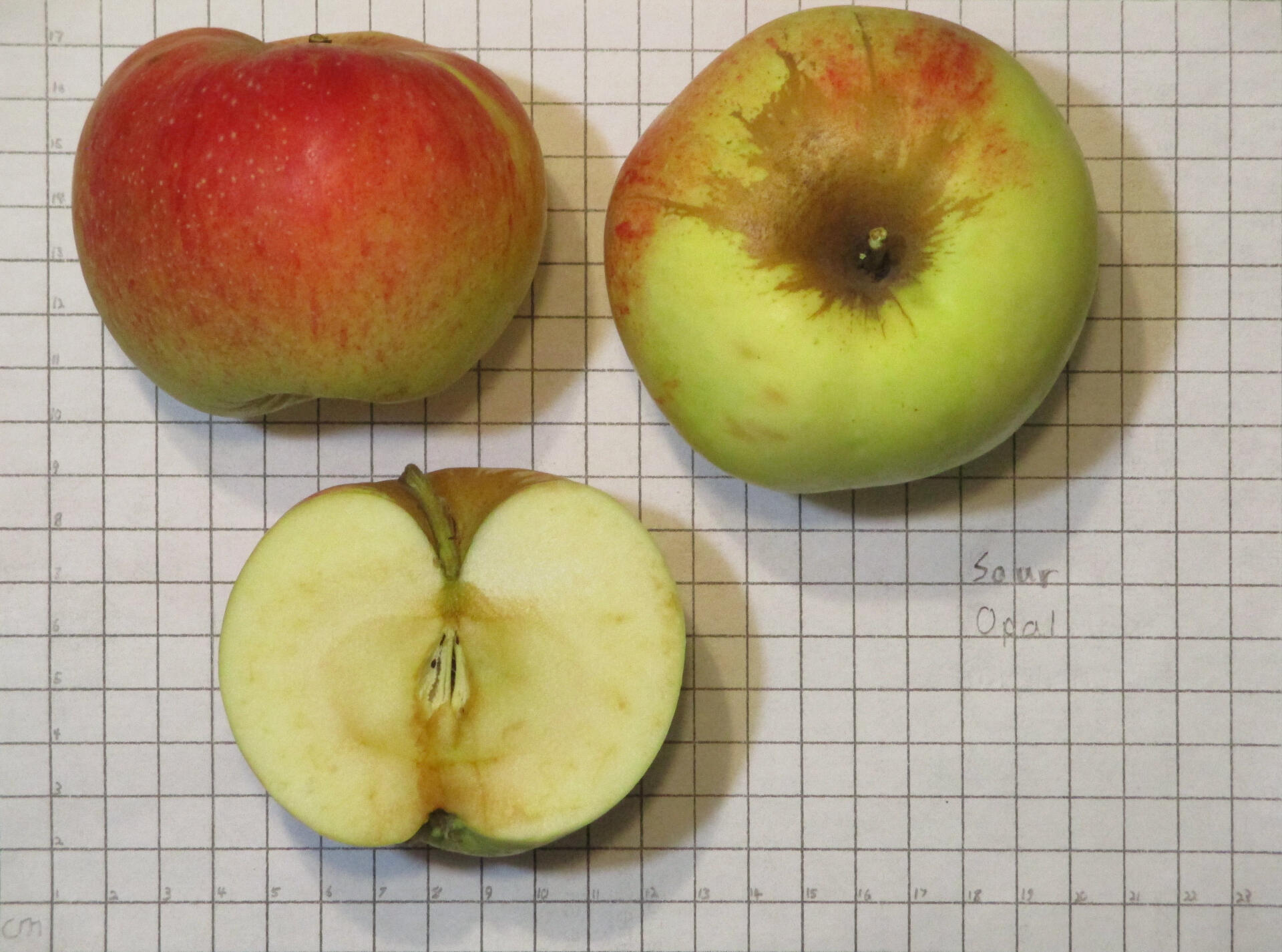
Sweet Sixteen
Sweet Sixteen is a excellent variety introduced by the University of Minnesota. Released in the late 1970s, it has been regionally popular since then. The fruit are vaguely conical, usually with a coppery red blush over most of the surface. Their cream colored flesh is crunchy and fine-grained with complex sweet and nearly spicy flavor, often compared to candy. Besides fresh eating, they cook well. They will keep for about a month, but their flavor deteriorates with storage. They ripen in mid season.
Info:
Use: Fresh Eating
Keeping: 1 Month
Bloom time: Group 4 (Late Season)
Ripening date: September 18th (Northern Wisconsin)
Parentage: Frostbite x Northern Spy
Origin: University of Minnesota - Introduced 1978
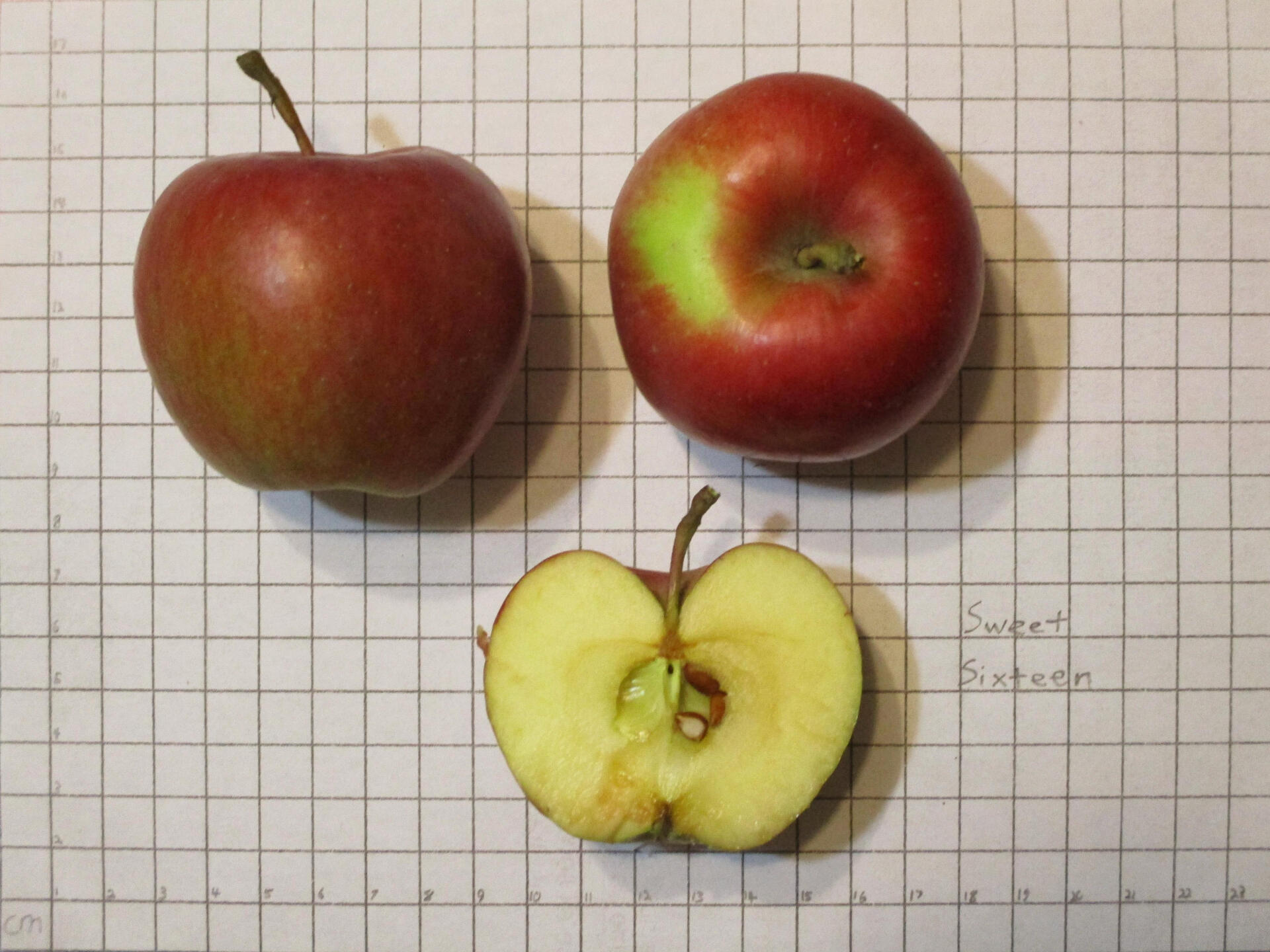
Tater House
Tater House is a seedling variety originating in northern Maine. It is large, and oblate or round. They are almost entirely coated with a dark violet-red flush. It is described as a good keeper, tasting better after a couple of months in storage, and as being of very good quality for eating. Our original stock came from Fedco Trees, of Maine
Info:
Use: Fresh Eating, Sauce
Keeping: 4 Months
Bloom time: Unknown
Ripening date: Unknown Late Season
Parentage: Unknown
Origin: Unknown - Maine
Trailman
Trailman is a summer ripening eating crabapple.
Wealthy
Wealthy is an old variety originating in Minnesota, notable for being suited to nearly any purpose. The apples are small and green, with abundant red striping, and ripen unevenly over several weeks. The flesh is fine-grained and firm, but not at all crunchy, and, when fully ripe, is pleasantly sweet. Slightly underripe, the fruit is energetic and tart. Besides being a joy to eat fresh, Wealthy also makes outstanding pies, and is good for applesauce. The fruit will keep for two or three months.
Wolf River
Wolf River is a large midseason cooking apple. The flat fruit are nearly pure rich red, with fine-grained white flesh. The apples stay firm and in good shape for about a month, allowing some time to use the tart flesh in sauce, pies, or baked. With the size of the fruit, very few are needed for any recipe. We acquired our original cuttings from Fedco Trees, in Maine.
Info:
Use: Baking
Keeping: 3 Weeks
Bloom time: Group 4 (Late Season)
Ripening date: September 20th (Northern Wisconsin)
Parentage: Possibly seedling of Alexander
Origin: Wolf River Valley, Wisconsin - Introduced sometime 1860-1870
Yellow Transparent
Yellow Transparent is an old summer favorite. When picked early, it is green, crisp and tart. If they are left to ripen fully they turn yellow and soften as they become sweeter. They have to be used quickly once they reach this stage, since they will only keep about a week, at most. Yellow Transparent is best for fresh eating and applesauce. It ripens in mid or late August.
Info:
Use: Fresh Eating, Sauce
Keeping: 1 Week
Bloom time: Group 2 (Early Season)
Ripening date: August 20th (Northern Wisconsin)
Parentage: Unknown
Origin: Russia - Introduced 1870
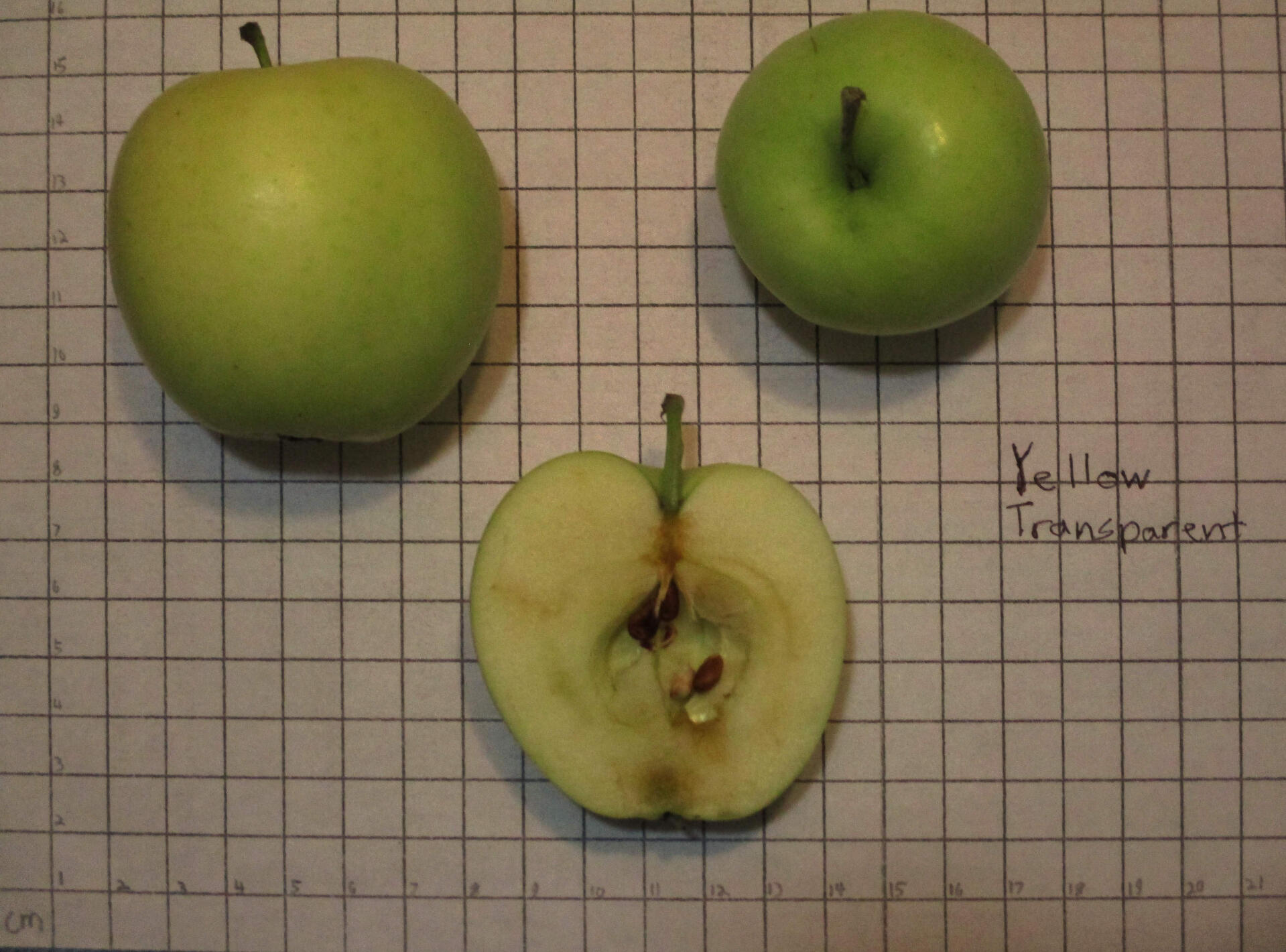
Contact Us/Order Trees
If you want to get in contact with us for any reason, please use the email form below, or email us directly at [email protected]. Ordering for the 2023 growing season opens December 1st, 2022. We cannot offer shipping on orders currently, so we will contact you in the spring when your order is ready, to arrange for you to come to the nursery to pick it up. (For planning purposes, we are located roughly a half hour east of Superior, WI.)Trees are $30 apiece, to be paid upon picking them up. We are also willing to discuss special orders and custom grafted trees of varieties we don't normally carry. This can include grafts of a personal favorite tree, or of a known variety not in our collection. These custom grafts will take one to two years to be ready. We can't offer grafts on different rootstocks for quantities less than ten trees.
The Project
Amnicon Apples is a small nursery currently able to produce a moderate selection of different apple trees. Our chief goal is to find new varieties in our local area that are worthy of introduction, as well as to provide a wide selection of old varieties, both obscure and popular. Every tree will be a variety supposed to be hardy up to USDA zone 3b, and will be grafted on hardy, quick bearing, semi-full rootstock.Our first year of production was 2020, and we are planting a portion of our grafted stock each year, to increase our production of cuttings. This will allow us to graft many more trees in the future than is currently possible. We also will try to add several new varieties to our selection each year.
Tree Care
Proper care is vital to get the full value of your trees. Correctly planting and protecting trees from animals are the most basic considerations. Other matters such as pruning are also important to successful apple growing. Below are some tips for how to handle each of these portions of horticulture.
Planting
How you plant your trees is the single most important factor for success which you can control. Improper planting can leave an otherwise healthy tree stunted, lacking vigor, or, depending on the soil, can drown or parch it to death.
Clay soils are the most difficult to plant in correctly. Heavy clay blocks the drainage of water, causing pools in any depression when it rains. Because of this, trees should be planted where there is at least some surface drainage, and usually should be placed in a mound rather than a hole. This keeps water from pooling around the roots and drowning the tree.
Loam soils are much less problematic. Trees should be planted in a hole with plenty of room for the roots, and, as long as the soil isn't waterlogged, the tree will not have trouble with moisture. The soil should hold water well enough to satisfy the tree's needs in nearly any circumstance.
Sandy soils are difficult to work with. Most dirt composed mainly of sand will not hold any water for the tree in dry spells, and until it is old, with a strong root system, the tree will probably struggle. When planting a tree in this type of ground, dig a large hole around where the tree will be, and mix large volumes of peat and other organic materials into the soil. These will hold water in dry spells, and greatly alleviate the need for watering to keep young trees alive.
So long as they are not drowning or lacking water, apple trees are extremely hardy to other environmental conditions. While there can be other problems with planting, they are too specialized for this overview.
Pests
The most common pests to attack apple trees are mammals. Deer, rabbits, and voles can cause major destruction in an orchard. Most other pests are rather minor compared to these voracious critters.
Deer are mainly a threat to young trees, when the tender recently grown branches are easily within reach to browse. A sturdy fence around your trees is the surest defense against deer. Other methods to discourage them from eating your trees are rather hit and miss in their effectiveness, as the beasts are notably capricious in what they will avoid.
Rabbits are a smaller threat than the other two troublesome herbivores, but are still able to badly damage trees. The most common form of rabbit damage is gnawing on the main trunk at the snow line in winter. In many cases, this girdles the tree, killing everything above the gnawing. Rabbits often do not totally kill trees, but set them back by years, as the tree has to completely regrow. Defenses against rabbits are fences, or various forms of trunk guards. Fences only work against large, fully grown rabbits, making them only partially effective. Tree wraps and trunk guards are universally successful against rabbits, but must extend above the snow line.
Voles are the most common and most difficult animal to keep away from trees. They are small mouse-like rodents which live in the grass. They build tunnels through the grass, or under the snow. Voles eat the bark of apple trees near the roots, girdling them like rabbits. Keeping grass near your trees mowed close to the ground discourages voles from living nearby, decreasing the chance that they choose your trees as their food source. Trunk guards and wraps fully protect from the pests. Trees need to be protected from both of the gnawing animals until the bark becomes thick and scaly, at which point it is too tough for most creatures.
Other pests, such are apple borers and various diseases can be just as destructive as any of these animals, but are much less common. There are plenty of resources on the internet or in your local library that will tell you ways to deal with these attacks, in the off chance you encounter any of them. Particular names to research on your own are the aforementioned apple borers, and a disease called fire blight.
Training
Our trees are grafted on vigorous roots, making them best suited growing as true trees. This involves removing all branches below a chosen height (usually between 4 and 6 feet), to keep a clear trunk, and then forcing the tree to branch out above that point. With correct pruning, the tree can be made to spread out widely, without becoming impractical to pick. Besides whatever minimal cutting is required to conform the tree to this structure, your new tree should be left alone as much as possible. Unnecessary pruning will set back fruiting, sometimes considerably. Once it begins to bear, the tree can be pruned normally, a process beyond the scope of this overview.
